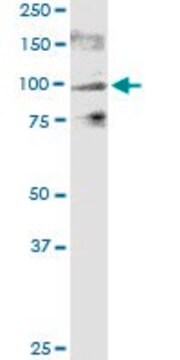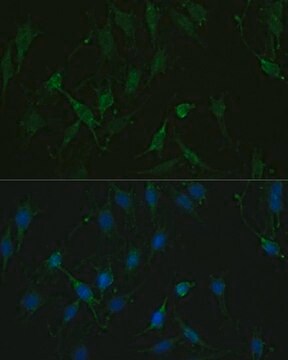一般說明
We are committed to bringing you greener alternative products, which adhere to one or more of The 12 Principles of Green Chemistry. This antibody is Preservative-free, produced without the harm or sacrifice of animals and exceptionally stable to allow for ambient shipping and storage if needed and thus aligns with "Waste Prevention", "Designing Safer Chemicals" and "Design for Energy Efficiency".
Click here for more information.
ZooMAb® antibodies represent an entirely new generation of recombinant monoclonal antibodies. Each ZooMAb® antibody is manufactured using our proprietary recombinant expression system, purified to homogeneity, and precisely dispensed to produce robust and highly reproducible lot-to-lot consistency. Only top-performing clones are released for use by researchers. Each antibody is validated for high specificity and affinity across multiple applications, including its most commonly used application. ZooMAb® antibodies are reliably available and ready to ship when you need them.
特異性
Clone 1N19 is a ZooMAb® rabbit recombinant monoclonal antibody that specifically detects TRPV1. It targets an epitope within 19 amino acids from the C-terminal, cytoplasmic domain.
免疫原
KLH-conjugated linear peptide corresponding to 19 amino acids from the C-terminal, cytoplasmic domain of human TRPV1.
應用
Quality Control Testing
Evaluated by Western Blotting in COS-7 cell lysate.
Western Blotting Analysis (WB): A 1:10,000 dilution of this antibody detected TRPV1 in COS-7 cell lysate.
Tested Applications
Western Blotting Analysis: A 1:1,000 dilution from a representative lot detected TRPV1 in Human dorsal root ganglia tissue lysates.
Immunocytochemistry Analysis: A 1:100 dilution from a representative lot detected TRPV1 in Neuro2A cells .
Immunohistochemistry (Paraffin) Analysis: A 1:1,000 dilution from a representative lot detected TRPV1 in Human kidney tissue sections.
Affinity Binding Assay: A representative lot of this antibody bound TRPV1 peptide with a binding affinity that was at least ten thousand-fold (10,000X) higher than that obtained with the non-specific control peptide.
Note: Actual optimal working dilutions must be determined by end user as specimens, and experimental conditions may vary with the end user.
標靶描述
Transient receptor potential cation channel subfamily V member 1 (UniProt: Q8NER1; also known as TrpV1, Capsaicin receptor, Osm-9-like TRP channel 1, OTRPC1, Vanilloid receptor 1) is encoded by the TRPV1 (also known as VR1) gene (Gene ID: 7442) in human. TRPV1 is a multi-pass membrane protein with four cytoplasmic domains, six transmembrane domains, and three extracellular domains. It serves as a ligand-activated non-selective calcium permeant cation channel that is involved in detection of noxious chemical and thermal stimuli. It also mediates proton influx and may be involved in intracellular acidosis in nociceptive neurons. It is also involved in mediation of inflammatory pain and hyperalgesia. Its channel activity is activated via the interaction with phosphoinositide interacting regulator of transient receptor potential channels (PIRT) and phosphatidylinositol 4,5-bisphosphate (PIP2). Both PIRT and PIP2 are required to activate channel activity. The channel is sensitized by ATP binding. Repeated stimulation of this channel with capsaicin leads to progressively smaller responses, due to desensitization. This desensitization is triggered by the influx of calcium ions and is inhibited by elevated ATP levels. Higher expression of TRPV1 channel has been reported in several chronic inflammatory diseases, including chronic asthma, rheumatoid arthritis, osteoarthritis, and erosive esophagitis. However, TRPV1 deficiency has been associated with upregulation of proinflammatory cytokines, such as TNF-α, IL-1β, and IL-6. This ZooMAb® recombinant monoclonal antibody, generated by our propriety technology, offers significantly enhanced specificity, affinity, reproducibility, and stability over conventional monoclonals. (Ref.: Bujak, JK., et al. (2019). Front. Oncol. 9; 1087; Feng, J., et al. (2017). Nat. Commun. 8; 980).
外觀
Purified recombinant rabbit monoclonal antibody IgG, lyophilized in PBS, 5% Trehalose, normal appearance a coarse or translucent resin. The PBS/trehalose components in the ZooMAb formulation can have the appearance of a semi-solid (bead like gel) after lyophilization. This is a normal phenomenon. Please follow the recommended reconstitution procedure in the data sheet to dissolve the semi-solid, bead-like, gel-appearing material. The resulting antibody solution is completely stable and functional as proven by full functional testing. Contains no biocide or preservatives, such as azide, or any animal by-products. Larger pack sizes provided as multiples of 25 µL.
重構
0.3 mg/mL after reconstitution at 25 µL per vial. Please refer to guidance on suggested starting dilutions and/or titers per application and sample type.
儲存和穩定性
Recommend storage of lyophilized product at 2-8°C; Before reconstitution, micro-centrifuge vials briefly to spin down material to bottom of the vial; Reconstitute each vial by adding 25 µL of filtered lab grade water or PBS; Reconstituted antibodies can be stored at 2-8°C, or -20°C for long term storage. Avoid repeated freeze-thaws.
其他說明
Concentration: Please refer to the Certificate of Analysis for the lot-specific concentration.
法律資訊
ZooMAb is a registered trademark of Merck KGaA, Darmstadt, Germany
免責聲明
Unless otherwise stated in our catalog or other company documentation accompanying the product(s), our products are intended for research use only and are not to be used for any other purpose, which includes but is not limited to, unauthorized commercial uses, in vitro diagnostic uses, ex vivo or in vivo therapeutic uses or any type of consumption or application to humans or animals.










